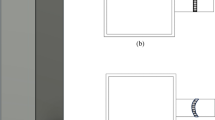Abstract
The present paper summarizes the application of two different types of stemming material used in bench blasting. The two stemming material types, namely crushed aggregate and drill cuttings were opted in the present study. The blast trials were conducted on overburden rocks of Garnet Biotite Sillimanite Gneiss (GBSG) formations in one of the largest metalliferous mines of India. These rocks were exposed to polyphase deformations, high-grade metamorphism that comprised of various fissures, joints and foliation planes. An attempt was made through this paper to assess the influence of aggregate stemming material on blasting results. The study revealed that the quality of stemming material significantly influences the blasting performance in moderately strong (UCS 45 MPa) blasting benches of GBSG formations. Hence, the quality of stemming material must be considered in designing blast rounds in such overburden rock formations to achieve production targets. The results were assessed by fragment size measurement in the blasted muck-piles using image analysis technique, excavator performance anticipated by digging rate and muck-pile shape parameters. The fragment size and its distribution affected the digging rate of excavators. The use of crushed aggregate stemming material yielded better fragmentation results in comparison to the drill cuttings in such overburden rock formations. The average fragment size (K50) values for blasts stemmed with drill cuttings were (0.58–0.77 m) higher than that of blasts stemmed with crushed aggregate stemming material (0.45–0.59 m). The digging rate of shovels (34 m3) per hour was consistent and about 18 % higher in blasts stemmed with crushed aggregate stemming material. Muck-pile resulting from every blast was surveyed and throw distance was measured. The average muck-pile throw were 21.2 % higher in blasts stemmed with drill cutting stemming material. Whereas vertical cratering was higher in blasts stemmed with crushed aggregate stemming material.











Similar content being viewed by others
References
Armstrong LW, Moxon NT, Sen GC (1993) The effect of confinement on fragmentation and movement. In: Proceedings of international symposium on rock fragmentation by blasting (Fragblast 4), Vienna, 5–8 July, pp 353–560
Bagde MN, Raina AK, Chakraborty AK, Jethwa JL (2002) Rock mass characterization by fractal dimension. Eng Geol 63(1–2):141–155
Boshoff D, Webber-Youngman RCW (2011) Testing stemming performance, possible or not? J South Afr Inst Min Metall 111(12). ISSN: 0038-223X
Cevizci H (2012) A newly developed plaster stemming method for blasting. J South Afr Inst Min Metall 112(12). ISSN: 0038-223X
Cevizci H, Ozkahraman HT (2012) The effect of blast hole stemming length to rock pile fragmentation at limestone quarries. Int J Rock Mech Min Sci 53(2012):32–35
Chavez R, Chantry R (2003) Actual benefits from new technologies related to constant timing with electronic detonators and uniform energy control. In: Holmberg R (ed) Explosives and blasting technique: proceedings of EFEE Second World Conference on Explosives and Blasting Technique, 10–12 September 2003, Prague, Czech Republic. A.A. Balkema, Lisse, pp 303–312
Dobrilović M, Ester Z, Janković B (2005) Measurement in blast hole stem and influence of stemming material on blasting quality. Rudarsko-geološko-naftni zbornik 17(1):47–53
Floyd JL (1999) Explosive energy relief—the key to controlling over break. In: Proceedings of Explo-99, Kalgoorlie, WA, pp 147–153
Kanchibotla SS (2001) Optimum blasting? Is it minimum cost per broken rock or maximum value per broken rock? In: Proceedings of Explo-2001, Hunter Valley, NSW, pp 35–40
Kojovic T (2005) Influence of aggregate stemming in blasting on the SAG mill performance. Miner Eng 18:1398–1404
Marton A, Crookes R (2000) A case study in optimising fragmentation. AusIMM Proc 1:35–43
Morin MA, Ficarazzo F (2005) Monte Carlo simulation as a tool to predict blasting fragmentation based on the Kuz-Ram model. Comput Geosci 32:352–359
Moxon NT, Mead D, Richardson M (1993) Air decked blasting techniques: some collaborative experiments. Trans Inst Min Metall 102:A25–A30
Rai P (2002) Evaluation of the effects of some blast design parameters on fragmentation in opencast mines. PhD Thesis, 2002. BHU Varanasi, India
Rai P (2007) Modifications in the firing pattern, stemming column and bench stiffness for improved fragmentation in limestone quarry of the Philippines—a case study. J Inst Eng (India) Min Eng Issue 88:34–40
Rai P, Imperial FL (2005) Mesh area vis-à-vis blast performance in a limestone Quarry—a case study. Fragblast Int J Blast Fragm 9(4):219–232
Raina AK (2014) Modelling the fly rock in open pit bench blasting under difficult geo mining conditions. PhD Thesis, 2014.ISM Dhanbad, India
Singh SP, Yalcin T (2002) Effect of muck size distribution on scooping operations. J Int Soc Explos Eng 2002G(2002):315–325
Trivedi R, Singh TN, Raina AK (2014) Prediction of blast-induced fly rock in Indian limestone mines using neural networks. J Rock Mech Geotech Eng 6(2014):447–454
Trivedi Ratnesh, Singh TN, Gupta Neel (2015) Prediction of blast-induced fly rock in opencast mines using ANN and ANFIS. Geotech Geol Eng. doi:10.1007/s10706-015-9869-5
Yang HS, Rai P (2011) Characterization of fragment size vis-à-vis delay timing in quarry blasts. Powder Technol 211(1):120–126
Zhu Z, Xiea H, Mohanty B (2007) Numerical investigation of blasting-induced cracking in cylindrical rocks. Int J Rock Mech Min Sci 44(2007):412–424
Acknowledgments
The staff and management of the mine are whole-heartedly acknowledged for rendering the admirable support and assistance during the conduct of the research project.
Author information
Authors and Affiliations
Corresponding author
Rights and permissions
About this article
Cite this article
Sharma, S.K., Rai, P. Investigation of Crushed Aggregate as Stemming Material in Bench Blasting: A Case Study. Geotech Geol Eng 33, 1449–1463 (2015). https://doi.org/10.1007/s10706-015-9911-7
Received:
Accepted:
Published:
Issue Date:
DOI: https://doi.org/10.1007/s10706-015-9911-7




